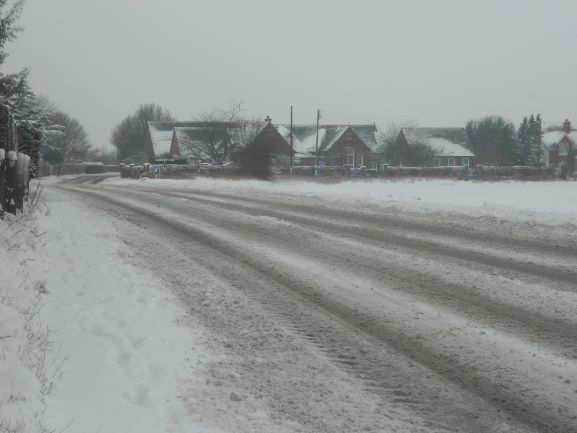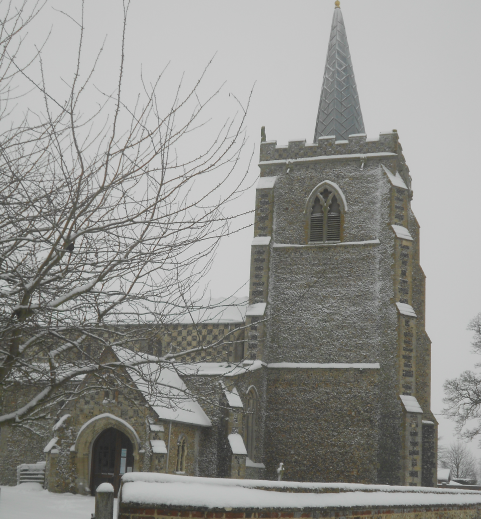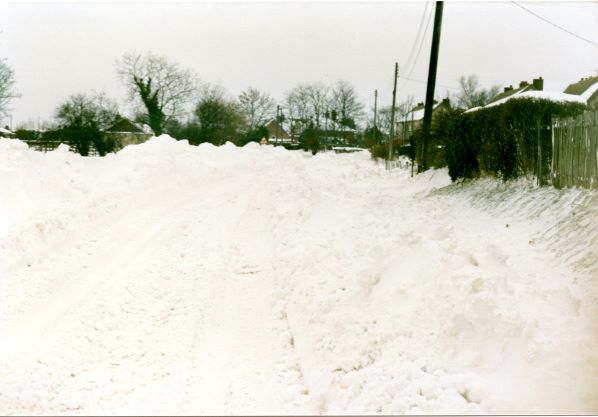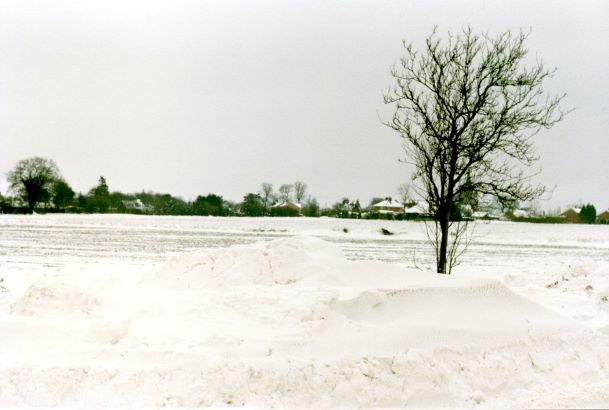
No doubt many of us will recall the cold winters of our childhood. I remember the snowy days in the sixties when we made sledges from almost anything we could lay our hands on. These were put together with nails and screws scavenged from someone’s Dad’s shed. Hours of fun in the snow until we could no longer feel our hands and feet!
We rolled huge snowballs to make snowmen. We scrounged pieces of coal for the eyes and carrots for noses and finished them off with someone’s hat stuck on the top. These snowmen would hang around for days (or even weeks), and be the last of the snow to disappear in the thaw that followed.
At night, an extra layer of clothing was sometimes needed to keep warm in bed. In the morning we could scrape patterns on the ice which had formed on the inside of the windows. I lived in a prefab with metal framed windows. We had one small open fire in the living room with paraffin heaters elsewhere to keep us warm. There was no central heating in those days!
There were always snowball fights with friends on the way to school. The longest ever glassy slide gradually appeared in the school playground. The silver tops on the bottles of school milk would be a good inch or more from the top of the bottle pushed up by the frozen milk.
Severe Winters of the Past
Many times my late mother-in-law Winnie recalled the severe winters of ’47 and ’63. I have some recollection of the winter of 1963 which, it has been said, was the coldest (then) since 1740.

I dipped into Pamela Brooks’ book The Norfolk Almanac of Disasters for any mention of severe weather for the months of January and February.
17th & 18th Centuries
The 24th February 1673 saw deep snow in Norwich which ‘laid on the ground for seven weeks’. I cannot see how Great Ellingham would have escaped this deep snow.
According to the ‘Norwich Remembrancer” the January of 1740, had “the coldest day in the memory of man” which was reported to be more intense than 1708 or 1715.
January 1776, saw snow drifts of up to 12 feet with the winter being considered the worst since 1740.
19th Century
Into the nineteenth century, the county was affected by heavy snowfall during February 1807, which was followed by a hurricane with sleet and snow. Shipping was affected along the coast. Again, I think it more than likely that Great Ellingham was affected to some degree by the heavy snow.
The following year (1808), the weather was worse with reports of snow drifts in Norfolk of up to 10 feet. Communications were obstructed.
The Norfolk Chronicle of 12th February, 1814, reported the loss of two sheep buried in snow in Great Ellingham.
Further heavy snowstorms with gales occurred across the whole country in 1854. Norfolk was also affected by heavy snowfalls of up to a foot deep in January 1861.
In the middle of January 1867, severe frost, heavy snow and a gale resulted in snow drifts of seven feet on the railway lines and roads were impassable.
Four feet drifts were reported at Dereham and five feet drifts at Harling. Great Ellingham, lying between the two, most likely was affected by large drifts. Four years later during February 1871, the county was affected by a major storm with heavy snowfall.
1947
The severe winter weather of 1947 began at the beginning of February with blizzards resulting in drifts of up to ten feet.
Attendance at the school in the village was low due to the severe weather. The milk delivery was unable to reach the school.
The teachers also had difficulty in getting to the school. The headmistress of Little Ellingham School, Mrs Womack, helped out at Great Ellingham, as she was unable to get to Little Ellingham. Children at the school were unable to take the Scholarship Examinations, again due to the bad weather.
1950s & 1960s
Blizzards also affected the county in 1955, 1958 and 1969 – all occurring in February.
The roads around Great Ellingham were blocked by snow and ice in mid-January of 1960. The toilets at the school were frozen and had to be thawed out.
As mentioned, the winter of 1963 was the coldest (then) since 1740. Santon Downham, some 25 miles from Great Ellingham, had 64 consecutive days with snow lying on the ground
1979
During the winter of 1979, Great Ellingham became isolated and the school was closed for the day. The weather was extremely cold with high winds and drifting snow.
1987
January 1987 also saw significant snowfalls in Great Ellingham.

January 1987. Photograph taken from Hingham Road looking towards the school.

Photograph taken January 1987 from Hingham Road looking south east across the fields towards the church (behind the tree).

Another photograph taken in January 1987 at Hingham Road looking towards Hingham. A car is just visible in the snow.
Sources:
Brooks, Pamela. (2007) The Norfolk Almanac of Disasters ISBN 978-1-85983-560-9 The Breedon Books Publishing Company Limited.
Watts, Jean. (1996) Great Ellingham Primary School Centenary 1896 to 1996. Great Ellingham County Primary School.
Norfolk Chronicle 12 February 1814